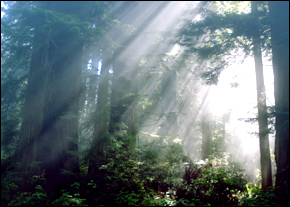Coastal Fog Trend Could Harm Iconic Redwoods
New study finds that lower levels of fog could leave coast redwoods more susceptible to drought damage.
 Reduced amounts of fog cover during the summer could be troublesome for the coast redwoods, according to a University of California at Berkeley study released Tuesday. Published in Proceedings of the National Academy of Sciences, the study suggests that lower levels of fog are exposing west coast habitat including redwoods to greater drought stress.
Reduced amounts of fog cover during the summer could be troublesome for the coast redwoods, according to a University of California at Berkeley study released Tuesday. Published in Proceedings of the National Academy of Sciences, the study suggests that lower levels of fog are exposing west coast habitat including redwoods to greater drought stress.
The coast redwood or Sequoia sempervirens is a giant, long-lived conifer with an extremely limited distribution. According to the International Union for Conservation of Nature (ICUN) Red List, the trees can only be found along a 725 km-long coastal belt spanning from Central California to southern Oregon. The ICUN lists the species under “vulnerable” conservation states with a decreasing population trend.
The redwoods have special adaptations that allow them to collect water directly from the atmosphere. This is especially crucial during summer months, when the trees compensate for dry conditions by obtaining about 40 percent of their water intake from atmospheric moisture according to Reuters.
To understand the fog frequency changes along the coast, lead researchers James Johnstone and Todd Dawson used historical data dating back to 1951. They then extrapolated fog conditions back during the early 1900s for which there is no historical record.
“Over the past 58 years, the coastal fog has decreased by about 1.3 hours a day,” Johnstone told Rueters.
Meanwhile the causes for the decreased fog frequency remain unclear. USA Today reports that the decrease in fog frequency could be due to natural oceanic and atmospheric variations. Climate change is also possibly a contributing factor, but Johnstone told USA Today that, “there is not clear evidence for this point.”
Even though Dawson told Reuters that it is possible that climate change plays some role in the disappearing fog, he describes how you would need an, “analysis of fog everywhere around the world, and how it’s changed everywhere around the world, to say okay, there’s this general global pattern.”
Sources: Reuters , USA Today, ICUN Red List, Proceedings of the National Academy of Sciences





